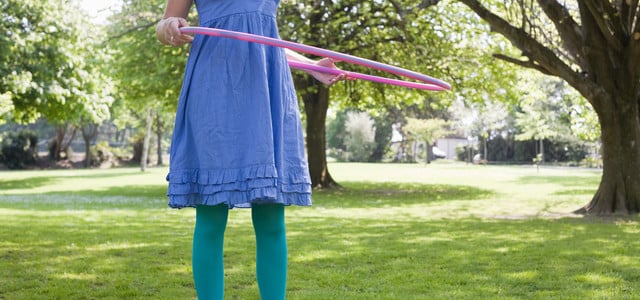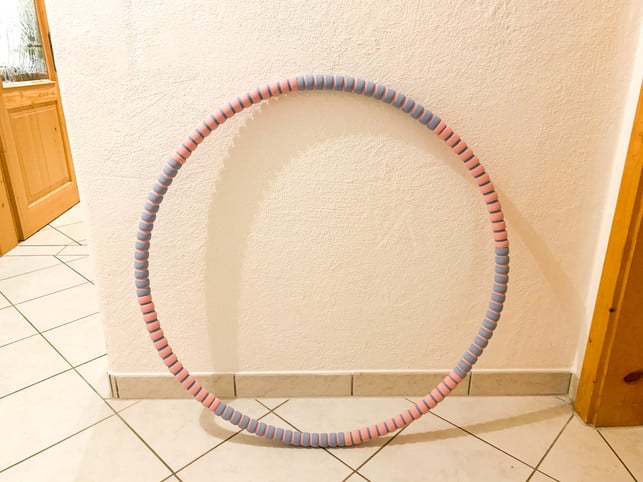
Learning to hula hoop isn’t difficult – and it’s worth it! In this article we have summarized why Hullern is good, how it works and what you should pay attention to.
You probably know hula hoop from your childhood. What was primarily a fun way to pass the time back then can now serve as an effective workout for you at home that doesn’t miss out on fun.
But how does hula hoop actually work? The goal is to let the tire circle around your body for as long as possible. The name is derived from a traditional Hawaiian dance (“hula”) and the English word for “hoop” (“hoop”).
The practical thing is that you don’t need much to learn how to hula hoop: a little space and a suitable hoop and the training can begin.
Learning to hula hoop is worth it

(Photo: CC0 / Pixabay / ravishahi)
Hula Hoop is considered an all-round sport that requires the entire body:
- trains different muscle groups: arm, leg, buttocks and (especially) abdominal and back muscles
- increases endurance and stamina as well as coordination
- promotes mobility
-
Tightens the tissue as it is massaged by the hoop and has better blood circulation
- strengthens the pelvic floor
Hula Hoop is popular because it brings variety to your sports routine, can give your sports motivation a boost, is fun for many people and can also be done on the side. Experienced hoopers can use the time while hulling: for example, to listen to music or podcasts or to watch television. You can easily integrate the sport into your everyday life. So learning hula hoop is worth it.
Another effect of hula hoop is the increased calorie consumption – depending on your basic constitution and the intensity of the hula hoop, you can burn between 200 and 300 calories in 30 minutes. So it seems quite possible to lose weight with Hula Hoop. Note that proper nutrition and sufficient exercise are important to lose weight healthily and effectively. In addition, you should only try to lose weight if you think it is good for you – and not to conform to common beauty ideals.
To make the training more intense, you can combine other exercises with the hula hoop, such as arm exercises. Or you dance while the hoop circles around your hips. So Hula Hoop doesn’t get boring.
Note: If you have back problems or complaints in the abdominal area, you should seek medical advice about whether and to what extent you can practice hula hooping.
Guide and tips to learn Hullern
When learning to hula hoop, it is important to stand and move correctly.
The starting position
- Place your feet hip-width apart and parallel to your shoulders. Bend your knees slightly. Straighten your back and tilt your pelvis slightly forward so that you don’t arch your back. Build tension in the abdominal area.
- Grab the hoop with both hands and align it parallel to the ground at waist level. Press it lightly against your lower back. The arms form approximately a right angle.
- It may be easier at first if you align the legs unequally. This means that you place one foot on the ground about 20 to 30 centimeters further forward.
The right movement:
- The first swing is important. You do this with your hands by giving the tire a good push to the left or right. Move your upper body in the opposite direction. Try out which side is easier for you.
- The legs stand still and are firmly anchored to the floor. Just move your upper body together with your hips and keep tension in your abdominal area (important!). You should keep your arms up, stretched or bent, so that they don’t get in the way of the circling hoop.
- The movement sequence can be either from right to left or from front to back. This means you’re pushing your body back and forth rather than moving it in a complete circle. Which direction you choose is up to you. You can also vary. At first, many people find it easier to move back and forth.
- Now carry out this movement evenly and rhythmically to the movement of the hula hoop. You can imagine it like this: Always press your body against the tire at the point where it touches your body.
If learning to hula hoop doesn’t go well at the beginning, don’t despair and stick with it. Once you have internalized the movement sequences and literally got the hang of it, it will be easy for you to keep the tire up. First of all, when it comes to Hullern you have to practice. Then the real training can begin.
More tips for learning to hula hoop
Learning to hula hoop is easy with these additional tips:
-
Space: Find a place in your apartment or outdoors where you have enough space to huller and there is no risk of knocking over something with the tire.
-
Clothing: Choose comfortable sports clothing. However, it should not be cut too wide, otherwise it will prevent the tire from rotating. If you want, you can train without your stomach, as the hula hoop sticks better to bare skin than to clothing.
-
Duration: Start with short training sessions to learn Hula Hoop and progress slowly. For example, initially you can exercise for five to ten minutes every other day and work up to 30 minutes a day.
-
Bruises: It is possible that bruises will occur, especially at the beginning, as your connective tissue first has to get used to the massage effect of the hula hoop. Then you should give your blood vessels time to regenerate. Once you are practiced, you no longer have to struggle with hematomas or pain from hulling.
-
Warm up: As before any sporting activity, you should warm up before hula hoop training by doing stretching exercises to prepare yourself for the movements. Focus on the torso, hips, thighs, shoulders and neck regions.
-
The right side: At the beginning, try out which direction of movement and rotation of the tire is easier for you: from left to right or from front to back or left or right. Once you’ve learned how to hula hoop, you can vary the directions and train the other side.
Which tire is the right one?

(Photo: utopia / baab)
There are a variety of hula hoops that vary in size, weight and material.
Choose the tire size according to your height. When you place it in front of you, the height of the hoop should be between your pubic bone and your belly button. A larger hoop is easier to keep up because the hoop takes longer to circle you. This gives you more time to carry out the movement. This makes it easier for you to learn hula hoop. Note: For hula hoop choreographies you need a hoop with a smaller diameter.
A heavier tire is also easier to hold up (due to the higher centrifugal force). At the same time, more weight puts more strain on your muscles and you burn more calories. However, you shouldn’t choose a tire that is too heavy at the beginning. A weight of around 1,000 grams is recommended for beginners. If you want to adjust the weight over time, you can choose a hollow tire whose weight can be increased with filling materials such as sand or rice.
There is also a wide choice when it comes to the material of the hula hoop. It can be made of plastic, have a stainless steel core or be covered with foam. A coating is particularly recommended for stainless steel, as the hard material can hurt when circling. The inner ring can be smooth, wavy or studded to increase the massage effect. Hula hoops are available in sports stores and online:
- made of plastic, covered with foam, wave-shaped (Amazon)
- with stainless steel core, covered with foam, fillable (Amazon)
- made of plastic, covered with foam, adjustable in size (Amazon)
There are currently not many sustainable tires on the market. Although wooden hula hoops are available, they are very light and often have a diameter that is too small. An alternative is the first hula hoop made from 100 percent recycled material, fairly produced in Germany.
We recommend buying a high-quality tire so that you can use it for as long as possible. To try out the sport first, you can also borrow a tire and buy a used one later.
Read more on Techzle\.com:
- Morning exercise: 8 reasons for a morning workout
- Exercise every day: is it healthy?
- Do sports: This is how you find the right sport
Edited by Annika Reketat
** marked with ** or orange underlined Links to sources of supply are partly partner links: If you buy here, you are actively supporting Techzle\.com, because we then receive a small part of the sales proceeds. More info.